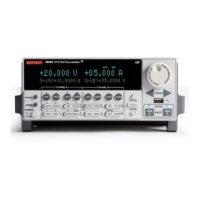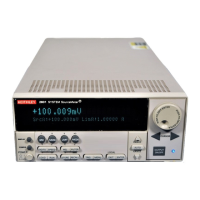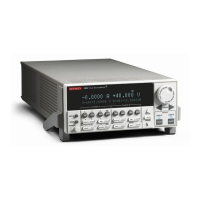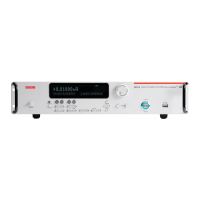19-14 Return to Section Topics 2600AS-901-01 Rev. B / September 2008
Section 19: Remote Commands Series 2600A System SourceMeter® Instruments Reference Manual
For example, the number of readings the reading buffer can store is accessed as rb.capacity.
Time and date values
Time and date values are represented as a number of seconds since some base. Representing
time as a number of seconds is referred to as “standard time format.” There are three time bases:
1. UTC 12:00 am Jan 1, 1970. Reading buffer base timestamps, calibration dates, and the value
returned by os.time() are all examples of UTC time.
2. When the Series 2600A is powered on. The value returned by os.clock() is referenced to
the power-on time.
3. Time referenced to an event, such as the first reading stored in a reading buffer.
Remote versus local state
The Series 2600A can be in either the local state or the remote state. When in the local state (REM
indicator off), the instrument is operated using the front panel controls. When in the remote state
(REM indicator on), instrument operation is being controlled by the PC. When the instrument is
powered-on, it will be in the local state.
Remote state
The following actions will place the instrument in the remote state:
• Sending a command from the PC to the instrument.
• Running a script (FACTORY or USER test) from the front panel. After the test is completed,
the instrument will return to the local mode.
• Opening communications between the instrument and Test Script Builder.
While in the remote state, front panel controls are disabled. However, the LOCAL key will be active if
it has not been locked out. When an interactive script is running, the front panel controls will be active
to allow the operator to input parameter values.
Local state
The following actions will cancel the remote state and return the instrument to the local state:
• Cycling power for the instrument.
• Pressing front panel LOCAL key (if it is not locked out).
• Sending the abort command from the PC.
• Clicking the Abort Execution icon on the toolbar of the Instrument Console for Test Script
Builder.
sourceoutputstates An array (TSL table) of strings indicating the state of the source
(Off or On).
sourceranges
An array (TSL table) of full-scale range values for the source
range used when the measurement was made.
sourcevalues If enabled (see collectsourcevalues above), an array (TSL
table) of the sourced value in effect at the time of the reading.
statuses An array (TSL table) of status values for all of the readings in the
buffer. The status values are floating-point numbers that encode
the status value into a floating-point value.
timestamps An array (TSL table) of time stamps, in seconds, between when
the reading was acquired and when the first reading in the buffer
was acquired. Adding this value to the base timestamp will give
the actual time the measurement was acquired.
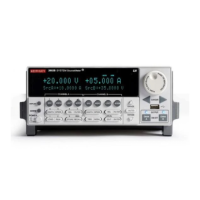
